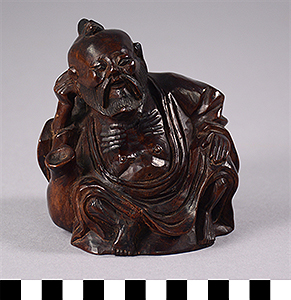| Description |
This is a Chinese lacquer carving of Li Bai, a notorious poet whose works influenced a number of twentieth century poets, including Ezra Pound and James Wright. He was also a famous imbiber and is often depicted joyously drinking in decorative arts.
The Spurlock museum holds a variety of Chinese lacquer figures created during the Qing Dynasty (1644-1911), and they serve as representations of regional beliefs and ethics, cultural figureheads, and the human condition. Common muses included famed scholars and poets, arhats (Buddhist holy men), bodhisattvas (Buddhists who have achieved enlightenment but choose to remain in the world to help others end their suffering), deities of East Asian belief structures, and the Chinese zodiac. Animals, plants, and other natural objects were also carved and are typically associated with good fortune and other favorable life conditions.
Confucian, Daoist, and Buddhist influences were evident in the art pieces of the Qing. All three schools of thought instructed the people of the East Asian region on the ways (dao) which people could pursue in order to reach human fulfillment within the world or beyond it. Confucian values, however, gained support among government bureaucrats. As a code of ethics which stressed strict hierarchy and an adherence to matters within the world (fangnei) rather than matters beyond it (fangwai), Confucianism was considered the superior ideological system for an effective government structure. In fact, it was believed that the Ming Dynasty (1368-1644) fell as a result of an openness towards Daoist and Buddhist beliefs as this encouraged needless speculation and even corruption. This resulted in Qing Confucianism developing an empirical approach which valued knowledge acquisition over a common ground between regional beliefs.
The carving technique of Chinese lacquer was a specialized practice due to the complicated drying process. Raw lacquer sap taken from the rhus tree species, particularly Rhus verniciflua, would not harden if applied too thickly, which meant that lacquer painting required a lengthy layering technique. Carved items of the commonly-used red lacquer style (ti hong) were not created until the Yuan Dynasty (1279-1368), and the lacquer manufacturing procedures are recorded for both the Yuan and early Ming (1368-1644) periods. A wooden base was covered with a thick layer of black lacquer (mixed with ash to promote hardening) which served as a smooth surface for the additional layers. A mixture of red and yellow layers, usually between 100 to 200, were then applied, and the artist then carved into these layers to produce a desired design. In order to indicate when the artist had to stop carving, several black layers would have been added as markers at an earlier point of the layering process.
Lacquerware was typically produced in government-sponsored workshops, though this was not always the case. In times of economic prosperity, the commercial workshops of southern China, particularly the southeastern provinces of the Song and Yuan periods (13th-14th century) and the late Ming era, were innovative in their approaches to creating lacquer items. Lacquer items from the Qing palace workshops were, at first, carved by craftsmen capable of overcoming the difficulties of lacquer carving due to their experience carving bamboo and ivory. However, the rapid political and economic decline of the Qing Dynasty following the reign of Qianlong (1735-1796) resulted in the closing down of many palace workshops, and the lacquer items made afterwards were fewer and had diminished in quality. |
| Bibliography |
Dursum, Brian A. et al. China’s Last Empire: The Art and Culture of the Qing Dynasty, 1644-1911. Coral Gables: Lowe Art Museum, 2014.
Hutt, Julia. Understanding Far Eastern Art: A Complete Guide to the Arts of China, Japan and Korea - Ceramics, Sculpture, Painting, Prints, Lacquer, Textiles and Metalwork. New York: E.P. Dutton, 1987.
Spurlock Museum of World Cultures. Sculpted Stories: Selected Works from the Fred Freund Collection. University of Illinois at Urbana-Champaign, n.d.
Watt, James C. Y., and Barbara Brennan Ford. East Asian Lacquer: The Florence and Herbert Irving Collection. New York: The Metropolitan Museum of Art, 1991.
|
